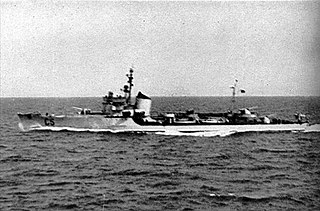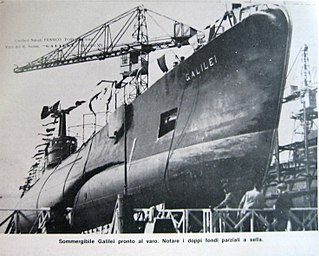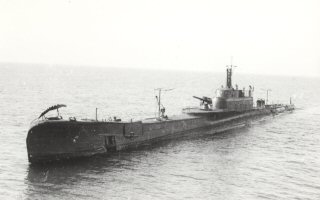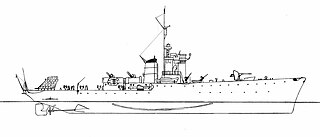Related Research Articles

The Regia Marina or Royal Italian Navy was the navy of the Kingdom of Italy from 1861 to 1946. In 1946, with the birth of the Italian Republic, the Regia Marina changed its name to Marina Militare.

The Spica class were a class of torpedo boats of the Regia Marina during World War II. These ships were built as a result of a clause in the Washington Naval Treaty, which stated that ships with a tonnage of less than 600 could be built in unlimited numbers. Thirty-two ships were built between 1934 and 1937, thirty of which entered service with Italy and two of which were sold to the Swedish Navy in 1940. The two units in Swedish service were classified as destroyers until 1953, then re-classified as corvettes. Although commonly referred to as torpedo boats due to their smaller displacement, the Spica class armaments were similar in design to destroyers and were intended for anti-submarine duties, although they often had to fight aircraft and surface forces as well. Twenty-three vessels were lost during World War II.
Enrico Toti was one of four Balilla-class submarines built for the Regia Marina during the late 1920s. The boat played a minor role in the Spanish Civil War of 1936–1939 supporting the Spanish Nationalists. She was the only Italian submarine to have sunk a Royal Navy submarine during the Second World War.

Galileo Galilei was one of four Archimede-class submarines built for the Regia Marina during the early 1930s. She was named after Galileo Galilei, an Italian astronomer and engineer.

The Balilla class were the first submarines to be built for the Italian navy following the end of World War I. They were large ocean-going cruiser submarines designed to operate in the Indian Ocean based in Italy's East African colonies. The design was double-hulled and based on the German Type UE 2 U-boats, one of which, U-120 was supplied to the Italians as a war reparation. A 425 horsepower (317 kW) auxiliary diesel engine was installed as an extra generator.

Ettore Fieramosca was an Italian submarine which served with the Regia Marina in World War II. She was named after Ettore Fieramosca, an Italian condottiero of the 16th century.

The Perla-class submarines were the third sub-class of the 600 Series of coastal submarines built for the Royal Italian Navy during the 1930s and named after gemstones. Of the ten boats built of this class, only three survived World War II.

The Gabbiano-class corvettes were a group of 59 vessels built for the Regia Marina of Italy for service during the Second World War. They were built to a war-time design and intended for anti-submarine and escort duties.

Leonardo da Vinci was a Marconi-class submarine of the Italian navy during World War II. It operated in the Atlantic from September 1940 until its loss in May 1943, and became the top scoring non-German submarine of the entire war.
The Italian 600 Series submarines were a series of submarine classes built for the Italian Royal Navy during the Inter war years.
The French submarine fleet of World War II was one of the largest in the world at that time. It saw action during the war but had a chequered service history due to France's position at that time. During the conflict, 59 submarines, more than three-quarters of the fleet, were lost.
Italian submarine Luigi Torelli was a Marconi-class submarine of the Italian navy during World War II. The vessel operated in the Atlantic from September 1940 until mid-1943, then was sent to the Far East. After Italy's surrender in 1943, the Luigi Torelli was taken over by Nazi Germany's Kriegsmarine, then, in the waning months of the war, the Japanese Imperial Navy. It was one of only two ships to serve in all three major Axis navies, the other being the Italian submarine Comandante Cappellini.

The Acciaio-class submarine was the fifth subclass of the 600 Series of coastal submarines built by the Regia Marina. They were completed during the early 1940s and saw service in World War II.

The Flutto class were a large class of submarines built for the Italian Royal Navy during the Second World War.

The Squalo-class submarines were a group of four submarines built for the Royal Italian Navy during the 1930s. They were built at the Cantieri Riuniti dell'Adriatico (CRDA) shipyard at Monfalcone, and designed by Curio Bernardis.

Italian submarine Adua was an Adua-class submarine built in the 1930s, serving in the Regia Marina during World War II. She was named after Adwa, a town in northern Ethiopia.

Italian submarine Gondar was an Adua-class submarine built for the Royal Italian Navy during the 1930s. It was named after a city of Gondar in northern Ethiopia.
Italian submarine Turchese was a Perla-class submarine built for the Royal Italian Navy during the 1930s. She was named after a gemstone Turquoise.
Guglielmotti was a Brin-class submarine built for the Royal Italian Navy during the 1930s.
Vedetta anti sommergibile, commonly abbreviated as VAS and also known in Italy as VAS Baglietto, was a class of motor torpedo boats that served as coastal anti-submarine patrol boats in the Regia Marina during World War II. Several boats that survived the war later served in the post-war Italian Navy.
References
- Bagnasco, E :Submarines of World War Two (1977) ISBN 0-85368-331-X
- Blair, C : Hitler’s U-Boat War Vol I (1996). ISBN 0-304-35260-8
- Gardiner, Robert; Chesneau, Roger, eds. (1980). Conway's All The World's Fighting Ships 1922–1946. London: Conway Maritime Press. ISBN 0-85177-146-7.
- Giorgerini, G : Uomini sul fondo (2002) ISBN 88-04-50537-0
- Miller, D :Submarines of the World (1991) ISBN 0-86101-562-2